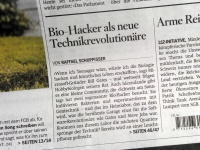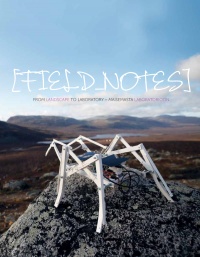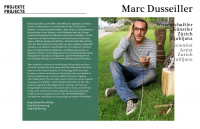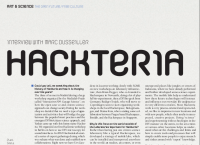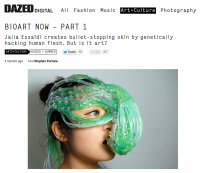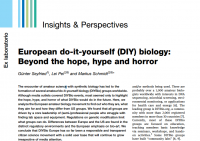Difference between revisions of "HSC"
(→= Related Readings) |
(→Related Readings) |
||
| Line 104: | Line 104: | ||
The events organized by Hackteria are rooted in a long tradition of media art, as well as process-oriented and performative approaches. Performative art is not equivalent to process-oriented art; as Andreas Broeckmann correctly pointed out, “it only makes sense to speak of process-orientation in cases where the evolving process itself is a main factor of the aesthetic experience of the work.” [4] Nonetheless, neither performative nor process-oriented art focus on the creation of a finite product, a distinctive trait of the activities run by Hackteria. Furthermore, the BioTehna project, for example, share both performative, interactive and process-oriented qualities, for it is not the lab as such that is meaningful to the artistic intent of the group but rather the process involved in building and running it. | The events organized by Hackteria are rooted in a long tradition of media art, as well as process-oriented and performative approaches. Performative art is not equivalent to process-oriented art; as Andreas Broeckmann correctly pointed out, “it only makes sense to speak of process-orientation in cases where the evolving process itself is a main factor of the aesthetic experience of the work.” [4] Nonetheless, neither performative nor process-oriented art focus on the creation of a finite product, a distinctive trait of the activities run by Hackteria. Furthermore, the BioTehna project, for example, share both performative, interactive and process-oriented qualities, for it is not the lab as such that is meaningful to the artistic intent of the group but rather the process involved in building and running it. | ||
| + | |||
[[File:Schweiz_am_Sonntag.jpg|right|thumb|200px]] | [[File:Schweiz_am_Sonntag.jpg|right|thumb|200px]] | ||
Revision as of 19:50, 1 August 2014
Hackteria Swiss Curriculum
The HSC – Hackteria Swiss Curriculum, a series of talks/presentations aiming to discuss openly the multitudes of bio art | sci | tec and related practices is a cooperation of Hackteria and Corner College, Kochstrasse 1, 8004 Zürich. Find map here.
Corner College
... ist ein offener Raum für unregelmässig stattfindende, quasi-akademische Aktivitäten wie Workshops, Vorträge, Lesungen, Filmvorführungen und kulinarische Versuche.
Das College wurde 2008 im Perla-Mode Zürich gegründet. Nach dem Umzug an die Kochstrasse 2011 wird es zurzeit von Irene Grillo, Sarah Infanger, Urs Lehni, Jeannette Polin, Philip Matesic und Stefan Wagner betrieben.
Team
Pei-Wen Liu
Interests: Nature vs Culture, and the soundings of them.
Short Bio: As a sound artist, I have been collecting field recordings with portable recorders over years in Australia, Taiwan, Europe, southern islands of Japan, northern-west of China and east Turkey, those soundings of nature phenomenons and human activities, or an emerging moment of small talk. Slowly I built a personal archive of sonic observations; with intensions or without. While most of artistic activity focus on listening and generative composition, as well, I am co-organising series of PlayAround workshop in Taiwan, an intensely parallel and collaborative workshop of mediating the creative use of fair software and DIY practices to an audience of young students and artists of diverse backgrounds, promoting sharism. It combines the knowledge creation and open distribution of new media technologies and contemporary art practices in a socially responsible and relevant context. MFA in Digital Media, Gothenburg University, Sweden.
Marc Dusseiller
Interests: Daphnia-Hacking, Euglena burgers, BioElectronics, low-cost diagnostics, building DIWO community bio-labs
Short Bio: Dr. Marc R. Dusseiller is a transdisciplinary scholar, lecturer for micro- and nanotechnology, cultural facilitator and artist. He works in an integral way to combine science, art and education. He performs DIY (do-it-yourself) workshops in lo-fi electronics, hardware hacking, microscopy, music and robotics. He was co-organizing Dock18, Room for Mediacultures, diy* festival (Zürich, Switzerland), KIBLIX 2011 (Maribor, Slovenia), workshops for artists, schools and children as the former president (2008-12) of the Swiss Mechatronic Art Society, SGMK. In collaboration with Kapelica Gallery, he has started the BioTehna Lab in Ljubljana (2012 - 2013), an open platform for interdisciplinary and artistic research on life sciences. Currently, he is developing means to perform bio- and nanotechnology research and dissemination, Hackteria | Open Source Biological Art, in a DIY / DIWO fashion in kitchens, ateliers and in developing countries.
Boris Magrini
Boris Magrini (*1975) is a Swiss art historian and curator. He earned a Master’s degree in art history and philosophy at the University of Geneva and is currently performing research for his PhD in the field of media arts at the University of Zurich, with a thesis on computer and generative art. He was curator at Duplex (Geneva), I Sotterranei dell’Arte (Monte Carasso) and assistant curator at Kunsthalle Fribourg and Kunsthalle Zürich. Among other projects, he has curated Mutamenti (Bellinzona, 2007), Anathema (Fri-Art, Fribourg, 2007-2008), Modifier (Dienstgebäude, Zurich, 2010) and co-curated Leise Rehe – Wilde Beeren (Cabaret Voltaire, Zurich, 2011-2012). In 2013, he has organized at Kunsthalle Zürich the series of talks and encounters Reality Check. He is editor of the Italian pages of the Swiss art journal Kunst-Bulletin and he regularly publishes on contemporary art and media art in magazines, books and exhibition catalogues.
Program Advisors
- Stefan Wagner - Corner College
- Jill Scott - ZHdK, Artists-in-Labs
- Baggenstoss/Rudolf - http://www.baggenstos-rudolf.ch/
- Sachiko Hirosue - EPFL, BioDESIGN.CC
Upcoming Aug-Dec
HSC#4: RealTechSupport presents: Postapocalyptic Water Design
* Date: 18.08.2014 – 20h * Main Speaker: Marc Böhlen (CH) – RealTechSupport
- Additional Guest: Sachiko Hirosue (JP/CH) on BIO-DESIGN for the REAL WORLD
- Moderator: Boris Magrini (CH), curator and art historian
More info on http://hackteria.org/discourse/hsc4
Potential Speakers | Sep - Dec
- Pavillon_45 - Nov http://pavillon35.polycinease.com/
- Jens Hauser
- Jill Scott http://jillscott.org/homepage.html
- Eugene Thacker
- Simon Park http://exploringtheinvisible.com/
- Sachiko Hirosue http://biodesign.cc/
- Brian Degger http://www.makerspace.org.uk/
- Center for Genomic Gastronomy http://genomicgastronomy.com/
- Nicola Triscott http://nicolatriscott.org/
HSC Series 2014
General Info about Hackteria
HSC#1: The case study and review of HackteriaLab 2014 – Yogyakarta
http://hackteria.org/discourse/hsc1-hackterialab2014/
HSC#2: Hybrid Ecology | The Finnish Society of Bioart
http://hackteria.org/discourse/hsc2-hybrid-ecology/
HSC#3: A critical perspective on bio-art between tactical media and artistic playground
http://hackteria.org/discourse/hsc3/
Related Readings
Hackteria: An example of neomodern activism. Leonardo Online 2013, Boris Magrini
http://www.leoalmanac.org/wp-content/uploads/2014/05/LeaVol20No1_-Magrini.pdf
As a platform for knowledge sharing and artistic exploration, Hackteria constitutes a network of artists and researchers that merge the use of biotechnologies with hacking and do-it-yourself strategies. Its process-oriented and performative approaches, opposing to the materialistic imperatives of the art market, lean to the tradition of political art. In the present paper, I am arguing that Hackteria embodies what could be considered a neomodern activism, other recent examples of which are emerging within the new media art field. Instead of rejecting new controversial technologies, they propose a vision of a society that is moved forward by a more democratic use and discussion of these technologies. The activities of Hackteria are examined through the presentation of a bio-lab created in Ljubljana.
The roots of Hackteria: from performative art to tactical media.
The events organized by Hackteria are rooted in a long tradition of media art, as well as process-oriented and performative approaches. Performative art is not equivalent to process-oriented art; as Andreas Broeckmann correctly pointed out, “it only makes sense to speak of process-orientation in cases where the evolving process itself is a main factor of the aesthetic experience of the work.” [4] Nonetheless, neither performative nor process-oriented art focus on the creation of a finite product, a distinctive trait of the activities run by Hackteria. Furthermore, the BioTehna project, for example, share both performative, interactive and process-oriented qualities, for it is not the lab as such that is meaningful to the artistic intent of the group but rather the process involved in building and running it.
Zu Besuch bei den Biohackern , Schweiz am Sonntag, Nr. 18, 5. Mai 2013 , R. Schuppisser
http://hackteria.org/2013/05/05/article-on-biohackers-in-schweiz-am-sonntag/
„... Bakterien kultivieren und mit Gentechnik experimentieren: Das geht auch im Heimlabor, nennt sich Amateur-Biologen bauen selber Laborinstrumente und träumen von leuchtenden Pflanzen. Einige auch vom grossen Geld.
DER ERSTE VERSUCH des Experiments ist fehlgeschlagen. Marc, Tuuli und Urs hatten verschiedene Fische gekauft, in Salzwasser eingelegt und einige Tage liegen gelassen. Nun sollten sich eigentlich die biolumineszierenden Bakterien auf dem Fisch vermehren, sodass man ihr Leuchten im Dunkeln erkennt. Die Bakterien sollten dann in einer Nährlösung aus Salzwasser, Pepton und Agar kultivieren. Doch nun muss erst einmal neuer Fisch her. Experimentieren im Heimlabor braucht Geduld. Marc, Urs und Tuuli sind Biohacker und damit Teil einer Bewegung, die die Welt ähnlich verändern könnte, wie in den 70er-Jahren die Computer-Tüftler mit der Entwicklung des PC in der Garage. Das zumindest glauben euphorische Journalisten und Technik-enthusiastische Wissenschafter. So meinte etwa der Physiker und Freidenker Freeman Dyson 2007 in einem Essay, «dass die domestizierte Biotechnologie unser Leben in den nächsten 50 Jahren mindestens so stark prägen werde, wie die Domestizierung des Computers in den letzten 50 Jahren». - ...„
«Ich will, dass Wissen und Technik der ganzen Welt zugänglich ist.» MARC DUSSEILLER, BIOHACKER
Field_Notes – From Landscape to Laboratory – Maisemasta Laboratorioon, Finnish Society of Bioart, 2013
http://bioartsociety.fi/Field_Notes_Teaser.pdf
Every second year the Finnish Society of Bioart invites a significant group of artists and scientists to the Kilpisjärvi Biological Station in Lapland/Finland to work for one week on topics related to art, biology and the environment. “Field_Notes – From Landscape to Laboratory” is the first in a series of publications originating from this field laboratory. It emphasizes the process of interaction between fieldwork, locality and the laboratory. Oron Catts, Antero Kare, Laura Beloff, Tarja Knuuttila amongst others explore the field and laboratory as sites for art&science practices.
BETWEEN LANDSCAPE AND LABORATORY
How to define the evolving field of art&science, including bioart, and where can the historical trajectory of this area within the arts be found? In very general terms one could divide currently existing artistic interests in the field into two very broad subject categories: artists that are concerned with the environment, and artists whose work focuses on the human as subject matter. The previous group deals with environment, landscape, natural phenomena, plants, and animals typically in their natural habitat. The latter group is interested in the human as such and within his technologically augmented environment. This includes work with human enhancement and organs, with devices and manipulation of human and animal cells. The work is carried out either under laboratory conditions or with technologically mediated social structures including human and non-human actors. Shared aspects across the field are e.g. politics, ethical debates and projections of the possible futures. This publication is specifically focusing on work that is concerned with the environment and ecology. However, the human is strongly present in all the arguments, statements and accounts. It is very apparent that we live in the era of the anthropocene, where viewpoints and actions are unavoidably developed with and projected from a human perspective.
The publication is edited by Laura Beloff, Erich Berger and Terike Haapoja. It is bilingual in Finnish and English and contains 17 articles and additional material of Finnish and international contributors. You can buy the book now from our website:
Home Made Bio Electronic Arts Do-it-yourself: Microscopes, Sensors, Sonifications - Christoph Merian Verlag / Migros-Kulturprozent: Dominik Landwehr, Verena Kuni (Ed.), 2013
http://hackteria.org/2013/05/23/home-made-bio-electronic-arts-published/
After 2 years of discussions with various people in the field of DIYbio, hackteria and BioArt, Dominik Landwehr and Verena Kuni published a new book in their HomeMade series. This time with the title “Home Made Bio Electronic Arts” they go some steps closer to interfacing the living world with DIY tinkering and electronics, easy accessible instructions for everybody. Additionally some editorial essays and an interview with Gerfried Stocker. A production by Migros-Kulturprozent with the Christoph Merian Verlag.
- Six easy do-it-yourself experimental projects
- For biotechnology and electronics do-it-yourself enthusiasts
“Science for all” is the motto of a new movement which deals with biology and electronics. It applies the do-it-yourself approach, well established in the electronic and computer scene, to natural sciences. Here the boundaries between the arts and sciences are fluid. The artists and scientists who work together in an interdisciplinary manner call themselves “bio-hackers” or “bio-punks” and deliberately continue in the creative tradition of those two movements. Their research is designed to communicate scientific insights which are otherwise reserved for scientists. Home Made Bio Electronic Arts introduces leading exponents and presents six easy do-it-yourself experimental projects.
The Art of Open and Free Science, MCD #68, 2012, Ed. A. Delfanti, Interview S. Tocchetti
http://www.digitalmcd.com/mcd-68-la-culture-libre-the-open/
Download the extracted pages from the Open Science section here.
Could you explain what is Open Source Biological Art and how it relates to DIY biology?
Whether it is a wiki or a workshop or both doesn’t really matter, what is essential is to enable people to collaborate and shaer knowle edge and instructions. Open Source Biological Art enables people to perform complex scientific protocols without the support of an official institution. We believe that it is important to enable more people to feel confident in working with living systems in order for creative and new ideas to emerge. When applied to science and art, it can create a new type of public participation and understanding of both domains.
What is your view on the future of citizen science?
My hope is that if more people are making things with their hands and have this direct and everyday experience with scientific protocols, we can demystify science and open the whole decision making process to more people and opinions. I think this is the future society, where I want to live, a place where tinkerers and lay people find new and unexpected uses and functions of technologies and scientific knowledge, where they hack it and adapt it to their dreams and lives and don’t wait for some big corporation or government to decide what is good or safe for them.
Der Aufstand der Bastler, November 2012, ABSTRAKT N°8 “Machen ist Macht”
Gespräch mit Marc Dusseiller. Von Max Celko.
In Garagenlaboren macht sich analog zu den Computernerds der späten Siebzigerjahre eine junge Generation von Amateurbiologen ans Werk: die Biohacker. Marc Dusseiller ist Gründer des Hacker-Netzwerks Hackteria. Dass in der Szene der Bill Gates der Do-it-yourself-Forschung zu finden ist, glaubt er aber trotzdem nicht.
... Worin liegt denn der gesellschaftliche Mehrwert des Selberforschens?
Ein zentraler gesellschaftlicher Nutzen ist es, dass die DIYBioszene auch Laien den Zugang zur wissenschaftlichen Diskussion ermöglicht. Damit wird die Biotechnologie zumindest ein Stück weit demokratisiert. Ich halte dies für sehr wichtig, denn wir stehen heute an einem Punkt, an dem die Biotechnologie rasante Fortschritte macht und völlig neue Möglichkeiten eröffnet, lebende Materie zu manipulieren. Es liegt jetzt an uns allen, gemeinsam als Gesellschaft zu definieren, welche Forschung wir möchten und welche gesetzlichen Schranken wir der Biotechnologie auferlegen. Als Folge des grösseren Wissens sind die Leute auch weniger anfällig für populistische Ideen von Politikern oder leere Marketingversprechen von Firmen.
Dazed & Confused: BIOART NOW: August 2013, S. Fortune
http://www.dazeddigital.com/artsandculture/article/16465/1/bioart-now-%E2%80%93-part-1
„... On the global stage biohacking collective Hackteria has lead the way on demystifing bioart and providing people with easy practical ways to engage with it. Formed in 2009 and featuring chapters in Europe, India and Indonesia the Hackteria Wikipedia has become the de-facto resource for all budding biohackers. The interplay between biohacking and bioart is particularly fluid among Hackteria affiliated practitioners. “Hackteria is not, generally speaking, about finished products or finished works. The bioart just happens, but is not the primary goal” said Hackteria co-founder Marc Dusseiller. Some of that 'incidental bioart' has been quite sublime. -....“
„...The Hackteria flavour of bioart and biotech education is particularly visible in Indonesia, where sister organisation Lifepatch complements the bioart residencies hosted by media-art lab the House of Natural Fiber (HONF), helping underfunded school students with such ingenious hacks as converting a webcam into a functioning microscope. At HONF in 2010, Julian Abraham and others initiated a project aimed at creating a safe form of fermentation based on tropical fruit, after the Indonesian government raised prohibitively high duties on alcohol. After leaving HONF, Abraham continued the theme, creating sound-based bioart pieces under the name Kapitän Biopunk. He provided workshops in homebrewing alcohol to accompany his Fermentation Madness, a sound-art piece that converts the processes of fermentation into an interactive soundscape. -....“
European do-it-yourself (DIY) biology: Beyond the hope, hype and horror, Günter Seyfried et. al. BioEssays, Volume 36, Issue 6, June 2014
http://onlinelibrary.wiley.com/doi/10.1002/bies.201300149/full
The encounter of amateur science with synthetic biology has led to the formation of several amateur/do-it-yourself biology (DIYBio) groups worldwide. Although media outlets covered DIYBio events, most seemed only to highlight the hope, hype, and horror of what DIYBio would do in the future. Here, we analyze the European amateur biology movement to find out who they are, what they aim for and how they differ from US groups. We found that all groups are driven by a core leadership of (semi-)professional people who struggle with finding lab space and equipment. Regulations on genetic modification limit what groups can do. Differences between Europe and the US are found in the distinct regulatory environments and the European emphasis on bio-art. We conclude that DIYBio Europe has so far been a responsible and transparent citizen science movement with a solid user base that will continue to grow irrespective of media attention.
Comparison between European and North American groups
The DIYBio movements in the US and Europe have a lot in common. Beliefs in the democratization of science and the enabling of citizens to do biotechnology are shared by all groups on both sides of the Atlantic. In general, they have more in common than what sets them apart. However, there also seems to be aspects where the groups in the US and Europe differ from one another.
In contrast to the USA (minding different state legislations), the groups in Europe need to obtain a license in order to carry out genetic engineering experiments. So far, the European groups have not done these types of experiments, but some of them plan to go through the licensing procedure and obtain a license. As an exception, the UK-Netherlands based C-LAB art collective did obtain a license to exhibit a bioart work with living genetically modified organisms in London, UK (http://c-lab.co.uk/projects.html). The work itself, however, was done in collaboration with a university research lab.
A rather surprising finding, compared to the US, is a stronger collaboration of amateur biologists with artists and designers in Europe. It remains to be seen whether this observation is only due to the small sample size of groups, or if the art-science interaction is a real European characteristic.
Forschen auf eigene Faust. Über einen Besuch bei Hobbybiologen in Los AngelesLena Stallmach 4. April 2012
http://hackteria.org/2012/04/04/diybio-article-and-interview-in-neue-zurcher-zeitung/
An article in today’s issue of NZZ (4. April 2012 Neue Zürcher Zeitung) gives a nice overview of the amateur biologist scene in LA. The journalist Lena Stallmach visited the people from LA biohackers in their own space/lab (which is currently in boxes, prepared for the move to a bigger space) and describes their working environment, dreams of inventions, ongoing projects and workshops in collaboration with the FBI.
In the interview dusjagr gives some info about the local movement in switzerland and the hackteria network, some critical reflections on the promises the DIYbio movement paralleling the agro/chem industries, the potential of garage biotech for developing countries and generally the role of DIY science in educating and empowering a democratic society.

